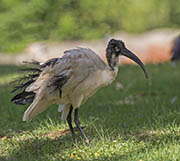Juvenile

12/09/2015 - Honolulu Zoo, Honolulu, HI
12/09/2015 - Honolulu Zoo, Honolulu, HI
|
|
|
Adult

07/09/2012 - San Diego Zoo's Wild Animal Park, San Diego, CA
07/09/2012 - San Diego Zoo's Wild Animal Park, San Diego, CA
|

07/09/2012 - San Diego Zoo's Wild Animal Park, San Diego, CA
07/09/2012 - San Diego Zoo's Wild Animal Park, San Diego, CA
|

07/09/2012 - San Diego Zoo's Wild Animal Park, San Diego, CA
07/09/2012 - San Diego Zoo's Wild Animal Park, San Diego, CA
|

07/09/2012 - San Diego Zoo's Wild Animal Park, San Diego, CA
07/09/2012 - San Diego Zoo's Wild Animal Park, San Diego, CA
|

03/13/2013 - Lowry Park Zoo, Tampa, FL
03/13/2013 - Lowry Park Zoo, Tampa, FL
|

09/03/2013 - Toronto Zoo, Toronto, Canada
09/03/2013 - Toronto Zoo, Toronto, Canada
|
Diet:
African Sacred Ibises eat a variety of foods including:
fish, frogs, small mammals, reptiles, nestling birds, eggs of birds
and crocodiles, mollusks, and frogs.
They also frequent human dumps.
Courtship:
During the breeding season, there may be some physical changes.
For example, their lower legs may be tinged with a reddish-copper color.
The courtship ritual includes a display where the heads and
necks are stretched out by each adult.
They bow and intertwine their necks while preening and calling out.
Nesting:
African Sacred Ibis will nest in colonies with other Ibis and other species.
The nest is a platform of sticks lined with leaves and grass.
The male gathers the material while the female builds the nest.
The nest is built in trees, bushes are on the ground.
Pair bonds are monogamous and last the breeding season.
The female will lay 2-3 dull white eggs with some reddish brown spots.
The chicks are fed by both parents.
Habitat and Range:
African Sacred Ibis are found in sub-Saharan Africa, the Middle East and Madagascar.
They were once found in Egypt but they are now extinct there.
Their habitat is varied.
They are found in inland waters,
cultivated lands, sewage works, playing fields, open grassveld,
rubbish dumps, coastal lagoons, tidal flats, and offshore islands
They roost nightly in large numbers.
Vocalization:
This bird is usually silent, but occasionally makes some croaking noises.
Plumage/Molt
Probably molts annually, no alternate or breeding plumage.
Migration:
In southern African some African Sacred Ibis are sedentary.
Other populations nearer the equator migrate small distances (several
hundred kilometers) during the breeding season.
Tongue/feet:
No additional information.
Bibliography:
- http://en.wikipedia.org The Free Encyclopedia, Accessed July, 2012
- http://edis.efas.ufl.eduq University of Flordia IFAS Extension, Accessed July, 2012
- http://www.eriezoo.org Erie Zoo, Erie, PA, Accessed July, 2012
- http://birdlife.org BirdLife International, Accessed July, 2012
- Maclean, Gordon Linday, Robert's Birds of Southern Africa,John Voelcker Bird Book Fund, 1985
Top of Page






